I don’t dare to follow Circle’s 7-fold surge, can I go long on Coinbase?
Original article from Artemis
Compiled by Odaily Planet Daily Golem ( @web3_golem )
Editor's note: Recently, Circle's strong performance since its listing has made investors who missed the opportunity feel anxious. Many investors who missed the opportunity are actively looking for alternatives to Circle. Among them, Coinbase has the highest voice. After all, it has a close business relationship with USDC. Investors widely believe that the market's future expectations for Circle and USDC can also be premium to Coinbase's stock price.
Artemis, an institutional data platform, said that many investors have recently suggested going long on Coinbase and shorting Circle. However, its fundamental analyst Kevin Li believes that investors should not go long on Coinbase just because they are bullish on Circle, because USDC-related revenue only accounts for a small share of Coinbase's total revenue. Although Coinbase is a huge ecosystem covering compliant exchanges, USDC, on-chain products and other businesses, its various businesses are currently under competitive pressure, and the situation is not optimistic. Investors still need to be cautious in pricing.
Odaily Planet Daily compiled Kevin Li’s comprehensive fundamental analysis of Coinbase as follows, enjoy~
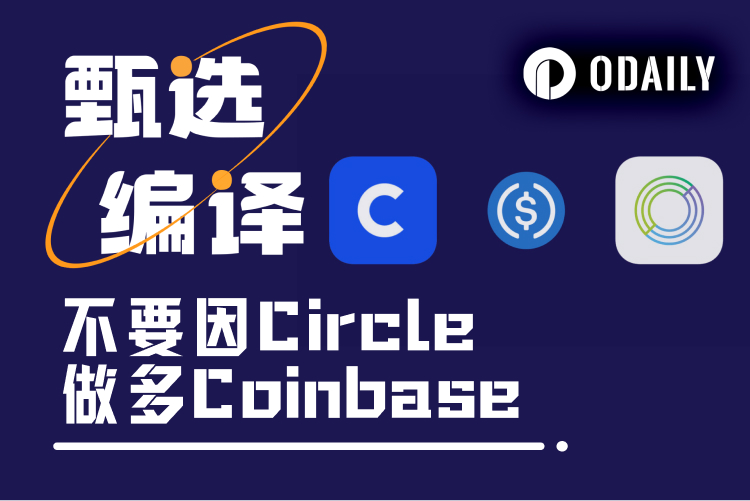
Summarize:
Stablecoin revenue growth is limited : Circle's IPO highlights the prospects of stablecoins, but Coinbase only has a small share in the USDC market economy. According to the revenue sharing agreement, Coinbase can obtain about 60% of USDC's total revenue, but can only keep a small part of it, because about 43% will be distributed to users as revenue, so Coinbase can actually only obtain 34% of the total stablecoin revenue.
Regulatory moats are fading : Coinbase has been a beneficiary of crypto regulatory uncertainty, using its expensive compliance infrastructure costs as a competitive moat. However, as regulation becomes friendlier and more transparent, and competitors become more dynamic, Coinbase's advantage will gradually weaken.
Exchange business under pressure : Coinbase's transaction commission has dropped from 2.5% to 1.4%, and its market share has dropped from more than 58% to about 38%, mainly due to fee compression and increasing competition from ETFs, decentralized exchanges (DEX) and TradFi platforms such as Robinhood. Coinbase is expanding subscription services (Coinbase One), staking, USDC interest income and derivatives business to offset the impact of weak spot trading volume on revenue. The proportion of trading revenue to total revenue has dropped from more than 90% in the previous cycle to about 55% in this cycle.
Base is gaining momentum : Coinbase’s Ethereum Layer 2 platform Base is growing rapidly in both transaction volume and profitability. It currently leads all Ethereum Layer 2s in transaction volume and active addresses, but still lags behind Solana in overall user activity and adoption momentum.
Derivatives gain momentum : Coinbase derivatives volumes have surged to over $300 billion per month, but monetization and long-term growth remain constrained by aggressive liquidity incentives and stiff competition from ETF-style cryptocurrency options.
Valuations look attractive : Comprehensive analysis puts Coinbase’s valuation at approximately $108.592 billion, but the market also correctly reflects the structural risks to its exchange’s moat and long-term profit margins.
Coinbase’s path to becoming an ecosystem giant
To understand the challenges Coinbase is facing today, and why it cannot completely replace Circle, it is important to look back to its origins. Coinbase was originally just a cryptocurrency exchange, which came into being at a time when it was still difficult for ordinary users to buy Bitcoin. With its intuitive and easy-to-use features, Coinbase quickly gained widespread adoption, and Coinbase's early proactive compliance measures also gave it a significant advantage, enabling it to expand its business in both retail and institutional markets.
Built on trust, convenience, and legal clarity, Coinbase quickly stood out among exchanges and had a loyal user base. Coinbase then turned its focus to expanding other profit opportunities, launching a premium subscription service, Coinbase One, and a staking product that allows users to earn income through assets.
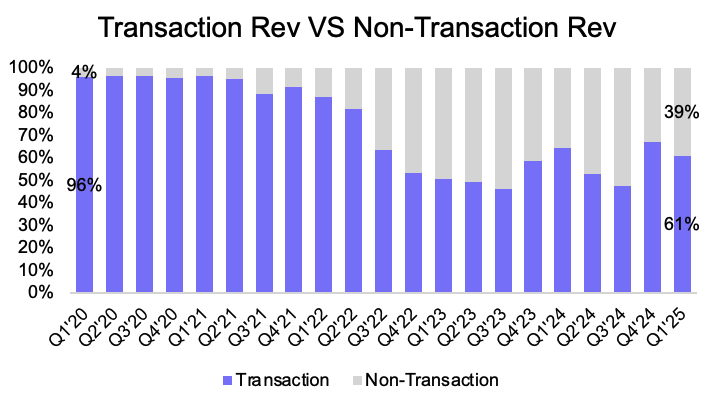
Coinbase transaction revenue as a percentage of total revenue has declined over time. Source: Coinbase quarterly reports, Artemis
As Coinbase's brand and influence continue to expand, Coinbase and Circle jointly launched USDC, a compliant stablecoin positioned as a replacement for USDT and BUSD. Coinbase's platform integration and reputation have accelerated the popularity of USDC. The highest USDC interest rate on Coinbase has reached about 5%, and the interest earned through USDC reserves has further increased Coinbase's revenue.
To complete its ecosystem, Coinbase launched Ethereum Layer 2 - Base in 2024. With this chain, Coinbase now controls a full-stack infrastructure: exchanges, stablecoins, and blockchains, forming a vertically integrated crypto ecosystem.
The exchange business and the brand it has built have always been the engine behind Coinbase's huge ecosystem. Subsequent products launched are not just new features, but also a way to convert the trust established between existing core users and exchanges into profits .
At its core, Coinbase’s business model follows a simple equation:
Revenue = Number of users × ARPU (average revenue per user)
The company's strategy has always focused on expanding both ends of this equation: expanding the user base through strong distribution channels and good regulatory credibility, and increasing ARPU by introducing new, value-added on-chain products in its ecosystem. Therefore, the core of its business is to acquire users through exchanges and increase profitability through a layered product stack.
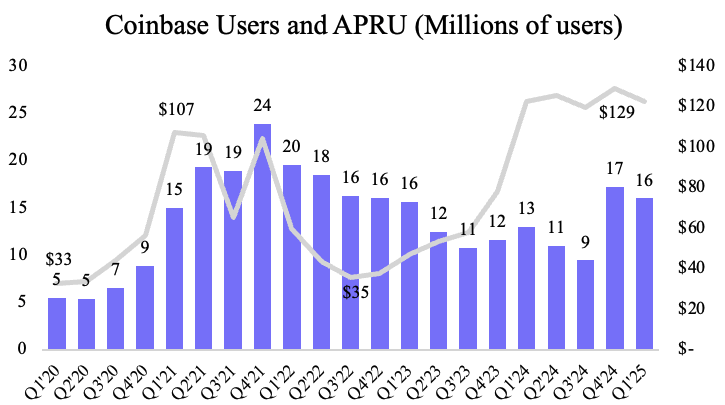
Coinbase's user growth has remained relatively stable, while ARPU (driven by commission rate + product line expansion) has increased over time. Source: Coinbase quarterly reports, Artemis, Data Ai
Coinbase is not a pure proxy for Circle or USDC
While Coinbase's ecosystem strategy is attractive, it also complicates the investment logic. Coinbase's wide range of businesses means it cannot be seen as a pure proxy for USDC or Circle. Currently, USDC-related revenue accounts for only 15% of Coinbase's total revenue, far less than the transaction fees of its exchange business. However, due to increasing competition from ETFs, decentralized exchanges (DEX), and TradFi platforms such as Robinhood, Coinbase's core revenue source is facing increasing pressure.
Therefore, buying Coinbase as an alternative to bullish Circle or USDC is not a wise investment choice . In order to cope with the fierce competition of traditional businesses, Coinbase attempts to diversify its business and get rid of the shackles of the trading business by building a broader and more lasting business model. Currently, Coinbase's business mainly covers four major sectors:
Cryptocurrency exchange business: This is the core business of Coinbase, and its revenue mainly comes from transaction fees.
Subscriptions and Blockchain Rewards: Includes products like Coinbase One and additional services for exchange businesses like institutional staking/custody.
USDC and Interest Income: This income source includes interest income from USDC reserves and interest income generated from cash held on Coinbase’s balance sheet.
Base: Transaction fee income from the Ethereum Layer 2 chain.

Coinbase revenue breakdown over time, with growing contributions from new business lines. Source: Coinbase quarterly reports, Artemis
USDC’s resurgence: Volumes are growing, but its dominance is waning
For investors watching the Circle IPO, the bullish case for Coinbase centers on its stablecoin business. USDC adoption is growing: more than 8 million of the 30 million active stablecoin addresses use USDC, weekly transactions have exceeded 300 million, and this upward momentum shows no signs of slowing down.

Active stablecoin addresses by token. Source: Artemis
Coinbase earns revenue from the U.S. Treasury bonds that back USDC and shares it with Circle. As the market value of USDC continues to rise, Coinbase's stablecoin-related revenue has grown to about $1 billion per year, accounting for about 20% of Coinbase's total revenue.
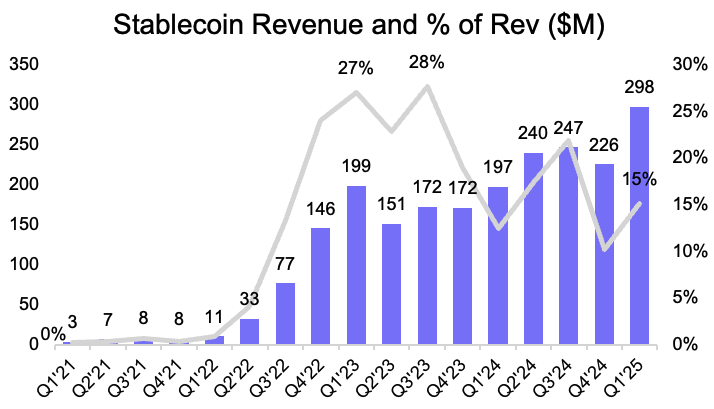
Coinbase’s stablecoin revenue and revenue share. Source: Coinbase quarterly report, Artemis
However, this figure masks the actual profits retained by Coinbase, as about half of the stablecoin-related revenue is returned to users in the form of staking income. Coinbase uses this return as a marketing strategy to retain users, but as competitors such as Robinhood also begin to offer users funding returns, Coinbase's appeal will decrease. Therefore, Coinbase's actual net stablecoin revenue is close to $171 million per quarter.
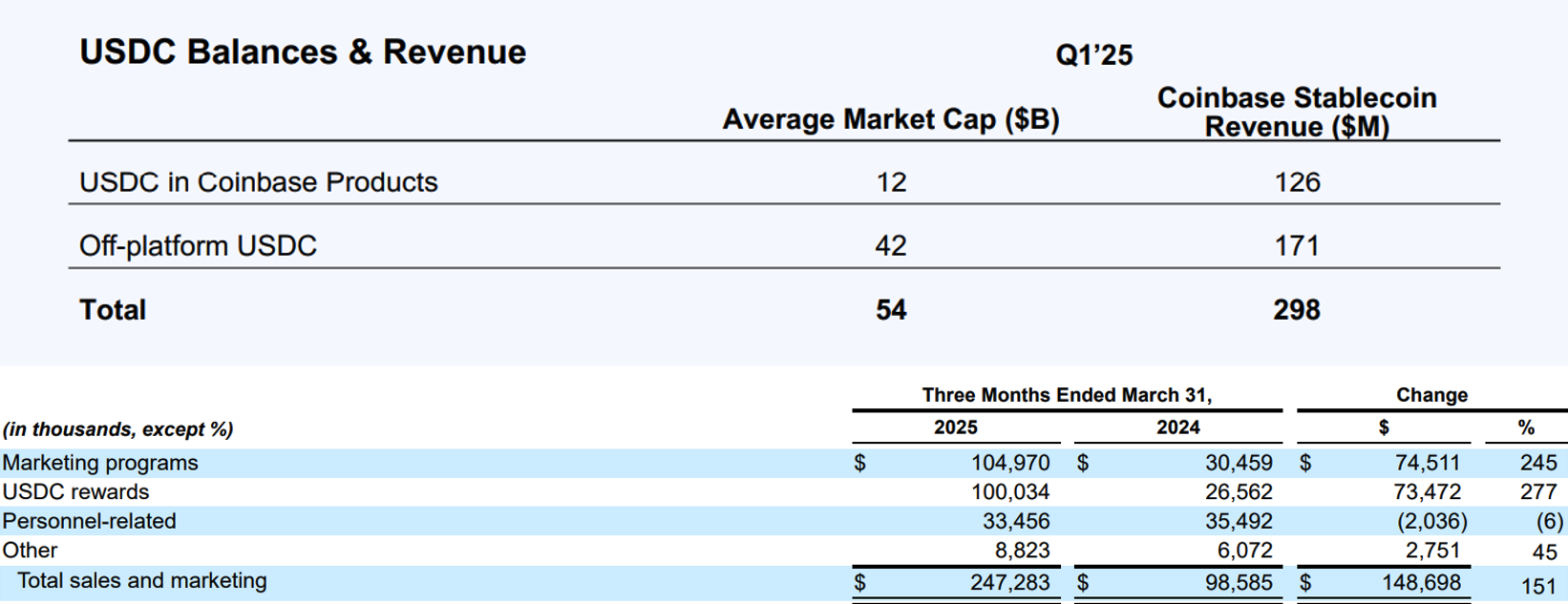
Coinbase stablecoin revenue distribution and Coinbase marketing cost structure. Source: Coinbase Q1 2025 financial report
In addition, USDC has long positioned itself as a stablecoin that complies with regulatory requirements and is closely tied to the US dollar ecosystem. Many believe that the United States may take regulatory actions similar to BUS on USDT, which is an asymmetric positive for USDC. Despite the expected regulatory pressure on USDT, it still dominates the stablecoin, accounting for about 75% of US dollar stablecoin transactions.
USDC has been slow to recover after the collapse of Silicon Valley Bank, and has not been well adopted in Canada, Bermuda, and Puerto Rico. At the same time, Cantor Fitzgerald holds a 5% stake in Tether (Odaily Note: Cantor Fitzgerald is a large comprehensive financial services company in the United States, one of the 24 "primary dealers" authorized by the Federal Reserve Bank, directly involved in the issuance and trading of U.S. Treasury bonds) and manages its $134 billion in assets under the leadership of Howard Lutnick, which shows that the regulatory risk of USDT is also decreasing and the compliance advantage of USDC is being weakened.
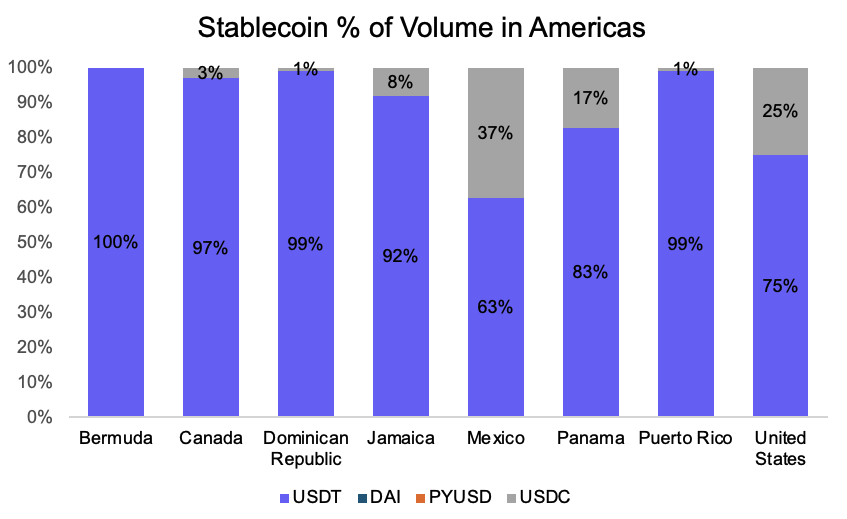
Comparison of USDC and USDT stablecoin trading volumes in the Americas. Source: Artemis
In summary, Coinbase shares economic benefits with Circle, but it has only received a small portion of USDC's gains. Tether still dominates the stablecoin market, and USDC's potential market share growth is still limited, which also limits Coinbase's risk exposure. Although Circle's stock price has risen parabolically, this largely reflects its expectations for future growth in the payment field.
Since Coinbase's contribution to USDC's growth mainly comes from the promotion of its trading platform, its driving role in the next stage of USDC's rise is limited. If you are optimistic about Circle, it would be better to invest directly in Circle than in Coinbase.

Stablecoin market share. Source : Artemis
Next, we’ll explore the growing pressures facing Coinbase’s other business lines, including its core exchange and on-chain infrastructure, to explain why investing in Coinbase now is a prudent idea.
Coinbase Exchange Business: Intensified Competition from ETFs and DEXs and Erosion of Coinbase’s Moat
The exchange business has always been supply-side driven, meaning that users will choose to go to exchanges that list the assets they need, and when compliance is no longer an issue, competitiveness depends more on which exchange can offer the latest hype or high-return tokens rather than brand loyalty. Emerging or popular tokens (especially in speculative or Meme coins) usually trigger a surge in user activity, and listing popular assets can significantly increase the exchange's trading volume and active users.
There are generally three different types of tokens on the market:
Blue chip assets: highly liquid, trusted, and generally considered “safe” (e.g. BTC, ETH, SOL).
VC coins: backed by a reliable team or have a certain degree of regulatory compliance (e.g. ADA, XRP, LINK).
MEME coins: high risk, high reward, often driving spikes in participation (e.g. FLOKI, APE, TURBO).
US retail and institutional users flow to ETFs
Prior to this cycle, Coinbase had been popular in the U.S. market with its extensive asset list and diverse trading pairs. However, the exchange landscape has changed dramatically. First, the rise of cryptocurrency ETFs has created a regulated and institution-friendly entry point, accelerating mainstream adoption and allowing traditional capital to enter the space without relying on platforms such as Coinbase. Institutions have been very fond of crypto ETFs, with Bitcoin ETFs surpassing $100 billion in AUM in just one year. In particular, BlackRock's IBIT ETF exceeded its gold ETF's 20-year AUM in less than 12 months.
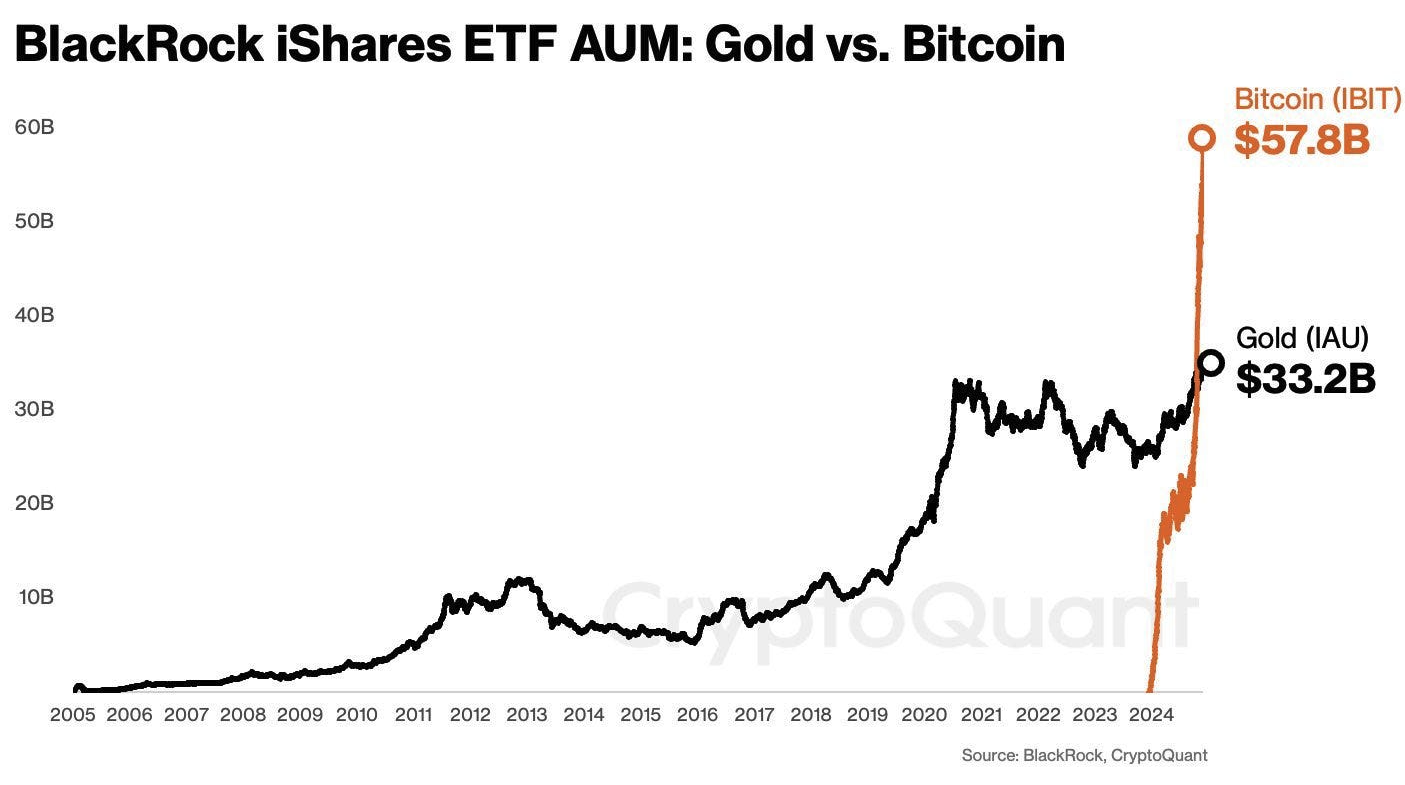
BlackRock's Bitcoin ETF's asset management scale has quickly surpassed its long-held gold ETF. Source: BlackRock
ETFs expand investment channels for blue-chip assets such as BTC and ETH, while also weakening a key advantage of Coinbase - as the main compliant platform for cryptocurrency investment in the United States. The growth opportunities that Coinbase once enjoyed exclusively are now divided up or even directly replaced by ETF tools, and more and more new American investors are entering the cryptocurrency market through ETFs rather than Coinbase. Although Coinbase will earn custody fees from some ETFs, these revenues are insignificant compared to the high transaction fees before.
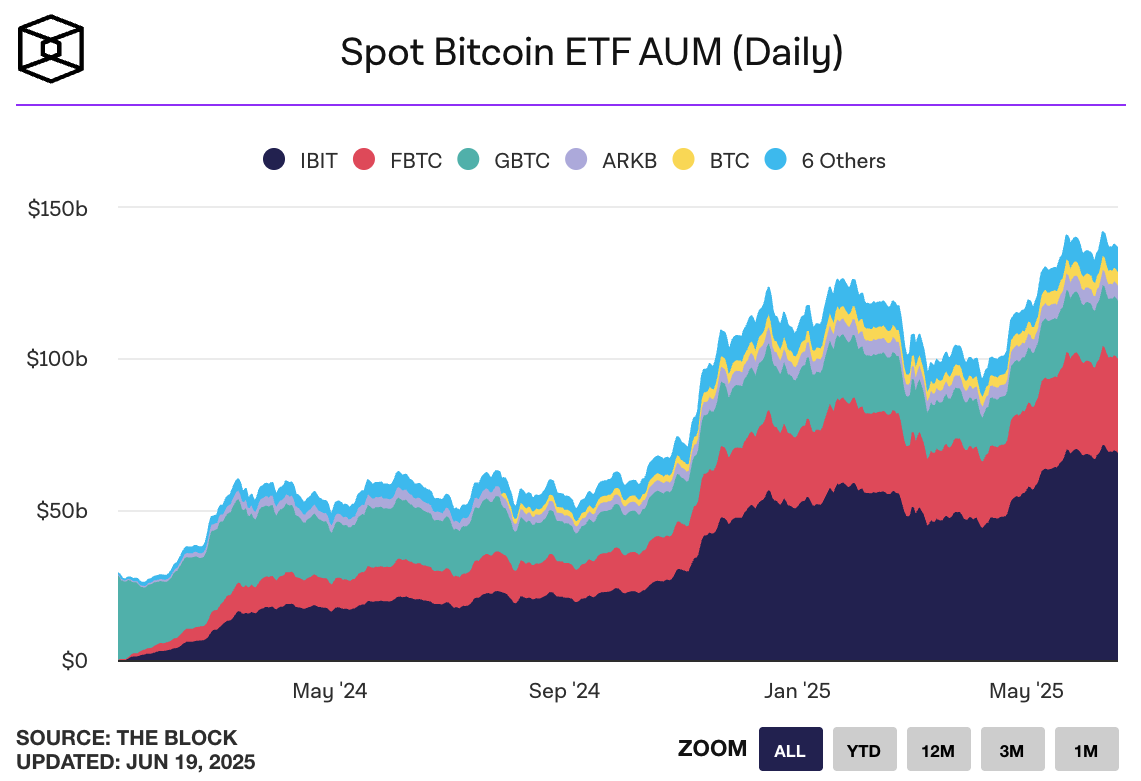
Bitcoin ETF asset management scale growth over time. Source: The Block
Missing the Solana Meme Coin Wave
On the other hand, the explosive growth of Meme Coin has triggered a new wave of retail speculation. Tools such as Pump.fun and Raydium have made token issuance easier than ever before, resulting in the number of tokens increasing nearly 30 times since the last cycle.
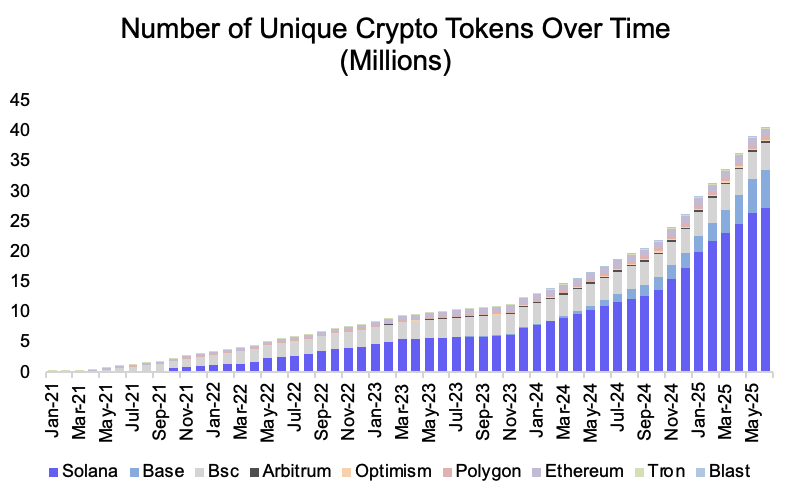
The number of unique crypto tokens has increased from less than 1 million in the last cycle to more than 30 million in this cycle. Source: Dune, @cgrogan
Due to strict compliance standards, Coinbase has been slow to list small tokens or meme coins. In contrast, the popularity of DEX has soared, providing instant liquidity for almost all tokens through permissionless, AMM-based. This gives DEX a clear advantage in speed and flexibility. For users seeking early, high-risk, high-return opportunities (especially in the meme coin field), DEX is often the only viable option.
The disadvantage for Coinbase is that the platform has limited integration with the Solana ecosystem (which has become the center of meme coin activity today). As a result, Coinbase has largely missed out on the Solana meme coin craze, while DEXs such as Raydium and Jupiter have captured the associated trading volume and user engagement.
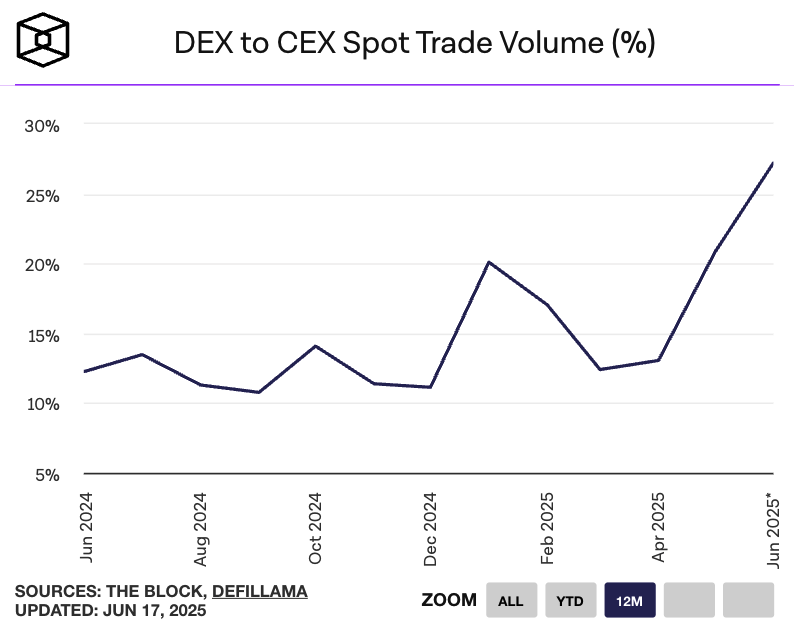
Spot trading volume from DEX to CEX doubled during this period. Source: The Block
Compliance advantage lost
In addition to the rise of ETFs and meme coins, the Trump administration has also released more friendly signals to cryptocurrencies, aiming to increase regulatory clarity and end the strong crackdown on the industry. For example, Trump's newly appointed SEC Chairman Paul Atkins quickly moved to rescind Gary Gensler's era against platforms such as Coinbase and Kraken.
As a result, traditional financial platforms with strong retail channels like Robinhood have also entered the crypto market. This shift is evident in the data: by the fourth quarter of 2024, Robinhood's retail revenue share of Coinbase increased from 32% to 76%, highlighting Coinbase's decline in market share. While regulatory clarity is good for the entire crypto industry, it also lowers the barrier to entry.
Whereas previously strict compliance policies favored well-resourced companies like Coinbase, the new, more relaxed regulatory regime allows smaller exchanges and traditional financial platforms to compete more effectively.
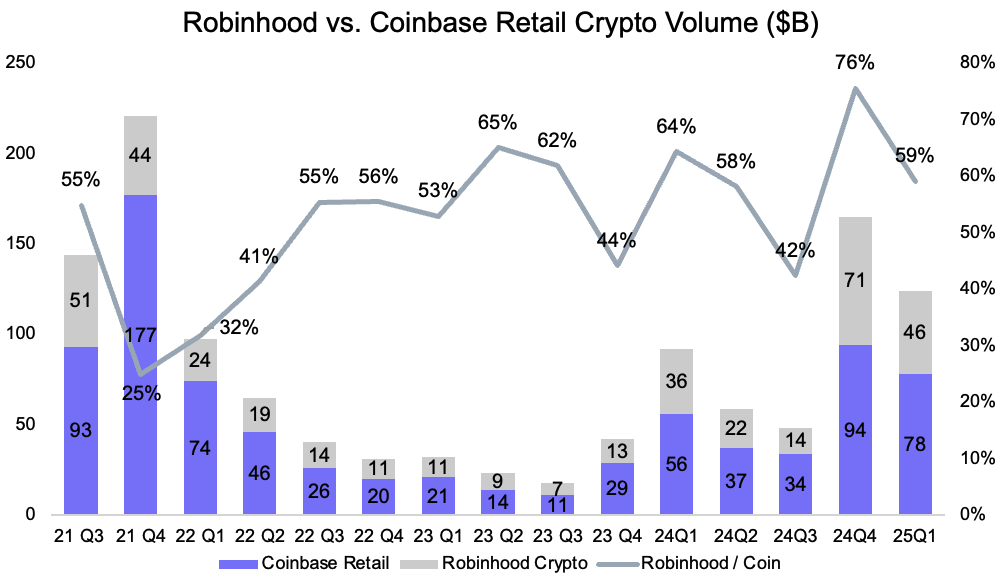
Robinhood's retail trading volume has grown significantly compared to Coinbase. Source: Coinbase quarterly report, Artemis
Increased competitiveness across the cryptocurrency market should put more pressure on Coinbase to reduce its high fees or risk losing market share. In fact, Coinbase’s share of volume on dollar-backed exchanges has fallen — from a peak of 60% to around 50% today, having fallen as low as 32% during the meme coin craze.
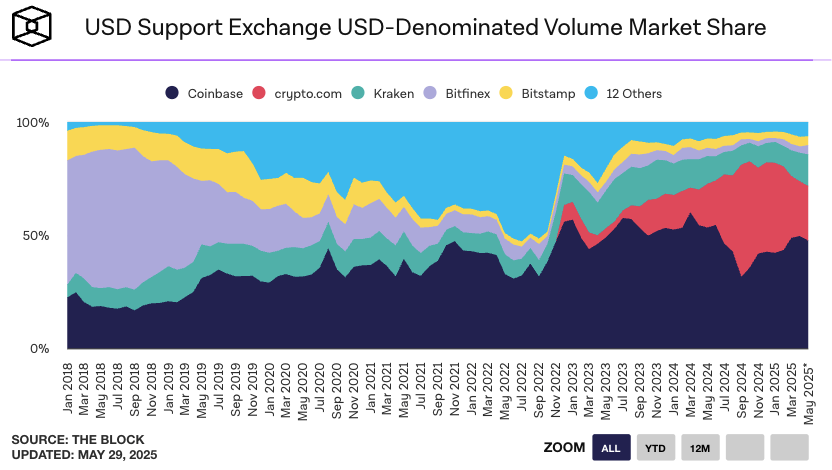
With the launch of ETFs and the rise of meme coins, Coinbase's market share in the US dollar-backed exchange market has declined. Source: The Block
More importantly, Coinbase’s volume commission rate has also dropped significantly, from a peak of 2.5% to around 1.4%. If it weren’t for the recent launch of derivatives, this drop would be even greater. It is worth noting that Coinbase’s commission rate soared in late 2022, just after the FTX crash, when Coinbase enjoyed a near-monopoly in the US market. This trend peaked in the fourth quarter of 2023, just before the launch of the Bitcoin ETF, which also marked the entry of cryptocurrency trading into a more competitive and institutional stage.

Coinbase’s retail commission rate has dropped from a peak of 2.5% to 1.4%. Source: Coinbase quarterly report, Artemis
Coinbase's new monetization business: derivatives and Base
Coinbase's competitive landscape has changed dramatically in this cycle. One end of Coinbase's core business model, "from exchange to on-chain economy," is already in jeopardy. Although Coinbase currently faces huge competition, there are three monetization businesses that may become its core pillars: derivatives market and Base.
Derivatives Market: Futures without expectations?
Derivatives remain the most profitable segment in cryptocurrency trading. In 2024, Coinbase launched a limited set of international derivatives products that have been rapidly adopted. Coinbase noted that while Q1 2025 results showed strong volume growth, derivatives are still in their early stages and could be key to attracting institutional users to monetize. However, due to ongoing marketing efforts, the impact of derivatives on revenue has been limited so far, as rebates and liquidity incentives have been offset by institutional trading revenue.
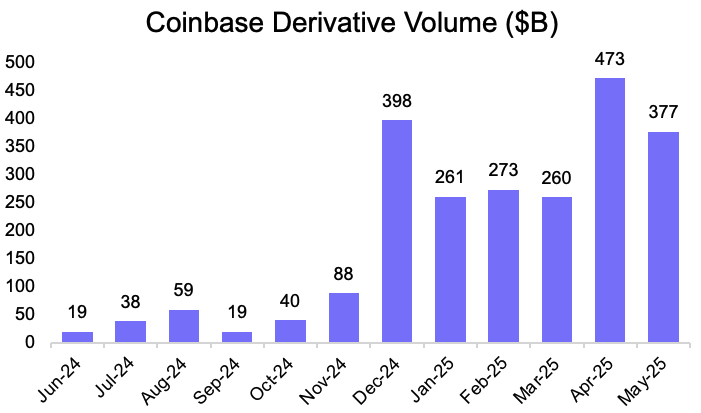
Coinbase derivatives trading volume surged after Trump won the presidential election. Source: Coingecko
The main goal of Coinbase's launch of derivatives in 2024 was to better monetize existing users and attract new users. However, except for a brief surge in users during the Meme season at the end of 2024, international user growth was minimal. Although derivatives contributed higher trading revenue, they did not significantly drive user growth.
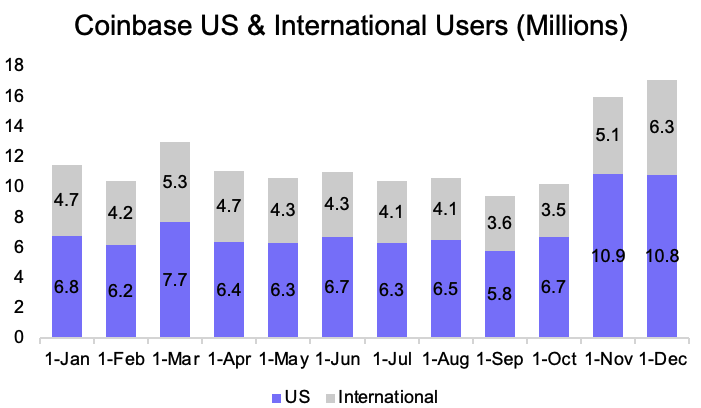
Coinbase's active domestic and overseas users change over time. Source: Data AI
In 2025, Coinbase began offering derivatives services to US users to better monetize its domestic user base. However, this launch coincided with the rapid rise of Bitcoin options linked to ETFs. Since most derivatives are concentrated on blue-chip assets such as BTC and ETH, Coinbase faces direct competition from ETF options, which further limits Coinbase's growth potential in this area.
In summary, while the derivatives business has become an important source of revenue for Coinbase in the short term, it still faces challenges in the long run unless it can break through limitations and attract new users in an increasingly crowded and fragmented exchange market.
Base: Coinbase bets on on-chain infrastructure
Base is Coinbase's Ethereum Layer 2 scaling platform, designed to bring users into the on-chain economy while diversifying Coinbase's revenue. Unlike other Layer 2 platforms, Base uses ETH as its native currency and has no native token. With Coinbase's brand and support, Base quickly gained popularity due to popular applications such as FriendTech and Farcaster, and became the Ethereum Layer 2 project with the highest transaction volume in its first year online.
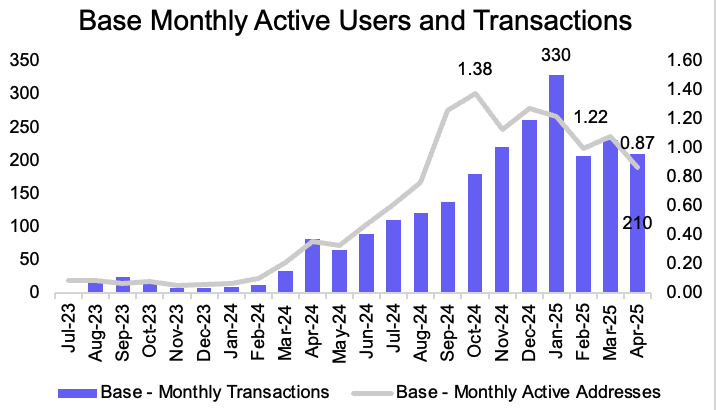
Figure 18: Base’s monthly active addresses and monthly transaction count. Source: Artemis
Coinbase has earned huge revenue by operating Base's sorter. According to Dune data, Base's gross profit is about $1 million per week, with a profit margin of about 90%. In addition, Base accounts for more than 75% of Ethereum Layer 2's total profits, highlighting its efficiency and market dominance. In addition to sorter fees, Base also introduces users to Coinbase's ecosystem through its wallets and applications, and generates revenue through cryptocurrency purchases, Swaps, and Base native applications. Base also supports Coinbase's B2B products such as Cloud, OnchainKit, and SDK. In addition, through its partnership with Optimism, Coinbase is expected to receive up to 118 million OP tokens over the next six years, which will be linked to Base's growth.
But Base’s core limitation is its positioning as a modular Ethereum L2, which has led to fragmentation among liquidity, users, and developers. Bridging assets from Ethereum increases loss, and limited interoperability between L2s also hinders seamless integration. These issues stem from differences in blockchain finality, making cross-chain liquidity transfers slow, costly, and complex. Despite tools such as AggLayer and cross-chain bridges, modular construction remains challenging.
As a result, Base has grown rapidly, but its adoption (measured in active users and transaction volume) still lags behind more unified, scalable monolithic chains such as Solana, which has three times the daily active users and seven times the daily transaction volume of Base.

Comparison of monthly active addresses and monthly transaction volumes between Base and Solana. Source: Artemis
How Much Is Coinbase Worth?
We will use the sum-of-the-parts valuation method, breaking it down into the following parts:
Exchange business: including transaction revenue, subscriptions and services, and blockchain rewards
Base Revenue: Revenue generated by Coinbase’s Layer 2 network Base
USDC Revenue: Share of Coinbase’s Revenue from the Partnership with Circle
Interest income Cash and USDC reserves generate interest income
Valuation of exchange business: $80.7 billion
Coinbase's exchange business is fundamentally both cyclical and increasingly competitive. To value it, we applied an average revenue multiple for traditional brokerage firms, which reflects a more stable and mature market structure.
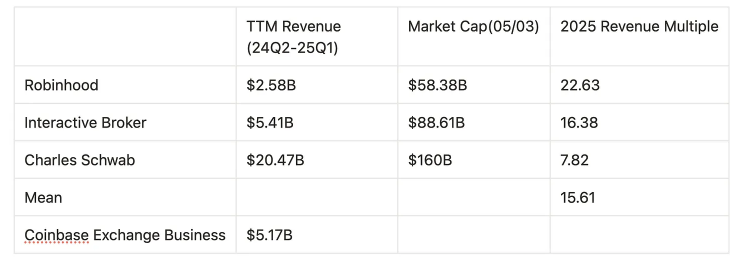
Using this multiplier, Coinbase’s exchange business is valued at: $5.17 billion × 156.1 = $80.7 billion.
Base business valuation: $1.86 billion
As part of our bullish thesis for Base, we took the average price-to-sales (MC/Revenue) ratio observed between Optimism (OP) and Arbitrum (ARB) and applied a multiplier of 270. Applying this formula to Base’s $68.7 million in annual revenue yields an implied market cap of $68.7 million × 270 = $18.5 billion.
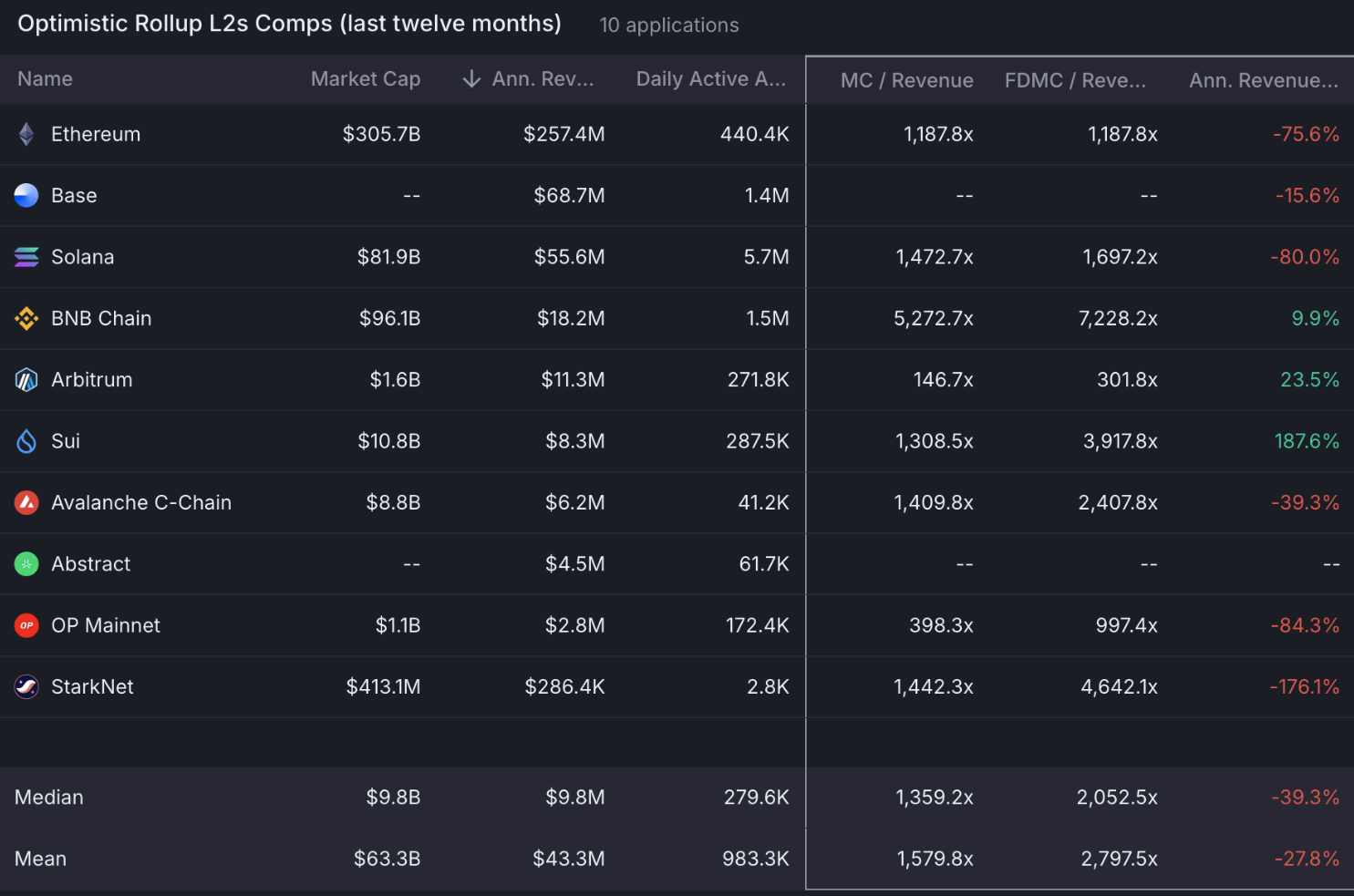
Ethereum L2 comparison chart. Source: Artemis
However, our base case applies a traditional tech valuation framework. Using a 30x P/E multiple and assuming a gross margin of approximately 90%, Base's implied gross profit is approximately $61.8 million, which yields a more conservative market cap valuation of $61.8 million × 30 = $1.86 billion.
This comparison highlights the huge valuation gap between token-based models and traditional financial frameworks. Given the speculative nature of current token P/E ratios, our analysis is based on traditional financial models that focus more on fundamentals.
USDC business valuation: $45.18 billion
Given that Circle has completed its IPO, valuing Coinbase's USDC-related business is relatively simple. Circle is currently valued at approximately $52.85 billion (as of June 23, 2025), which reflects Circle's 40% share of USDC revenue. Since Coinbase takes the remaining 60% and retains approximately 57% of it as net income (after distributing the proceeds to users), we can estimate the value of Coinbase's USDC-related business as follows:
52.85 billion USD × (6 ÷ 4) × 57% = approximately 45.18 billion USD
This means that USDC contributes approximately $45.18 billion in value to Coinbase.
Coinbase earns nearly $300 million in interest income annually on its $8 billion cash hoard. We factor this value directly into our SOTP valuation, which comes out to $8 billion.
In this way, the sum-of-categories valuation method shows that Coinbase's valuation may be approximately $108.592 billion (sum of categories * 80%), which means that the market may underestimate the company's valuation. However, this obvious difference from reality also reflects real and substantial risks.
Conclusion: Competition on all fronts in a diverse ecosystem
Coinbase's core trading business is under continued pressure from structural factors: ETF-driven disintermediation, fee compression on DEXs, and slowing user acquisition. At the same time, emerging revenue pillars like Base and USDC, while strategically important, are also facing increasing competition in their respective markets. USDC and interest income (a key driver of recent gains) are also vulnerable to falling interest rates and yield pass-through pressures, which limit further profit capture.
In short, Coinbase is evolving into a diversified crypto ecosystem, but every part of that model is now facing headwinds. While Coinbase may be undervalued from a purely financial perspective, the market's cautious attitude also reflects rational pricing for its shrinking moat, margin pressures, and competitive vulnerability.



